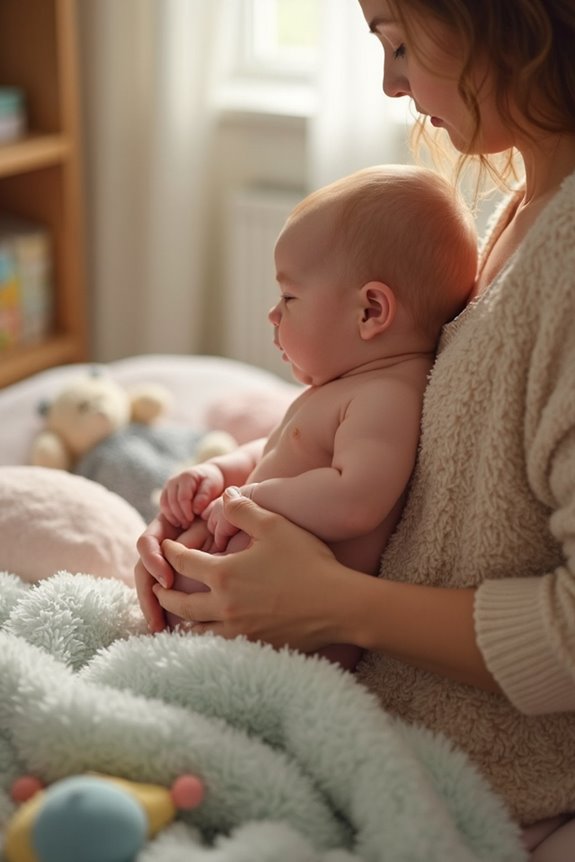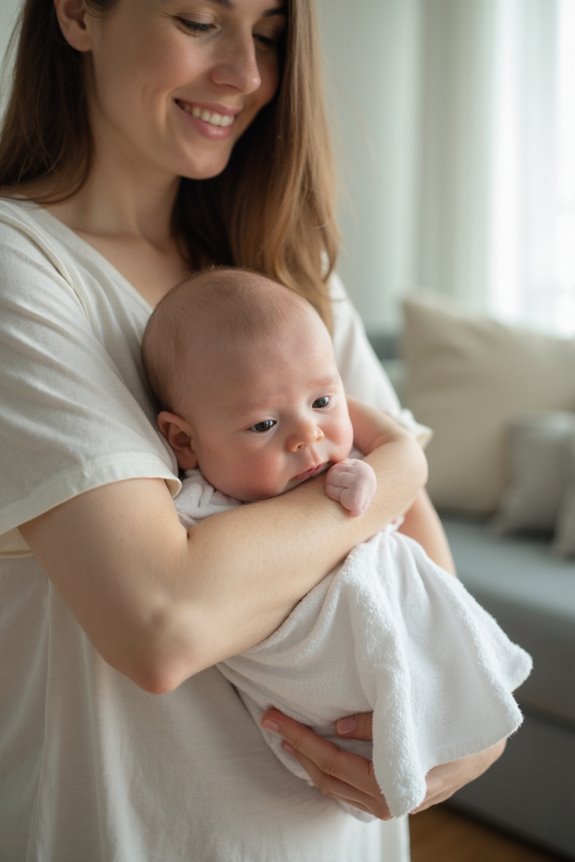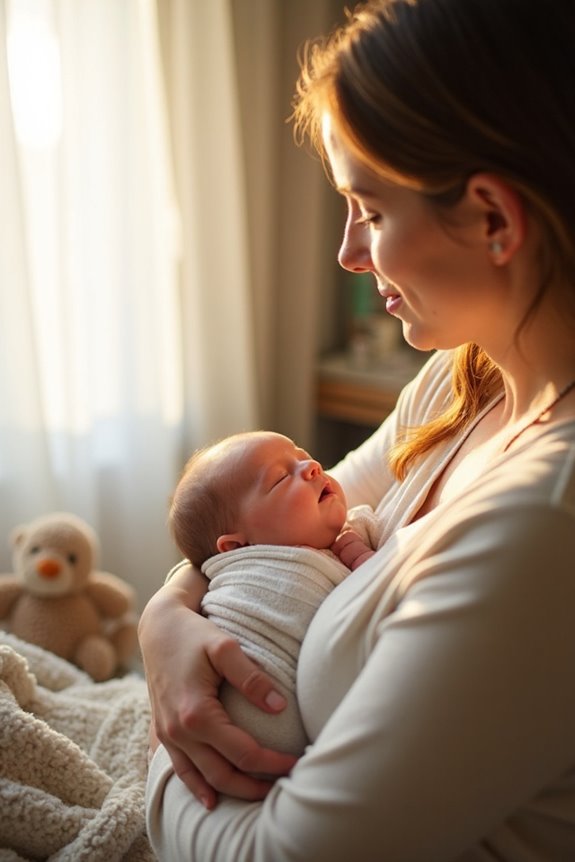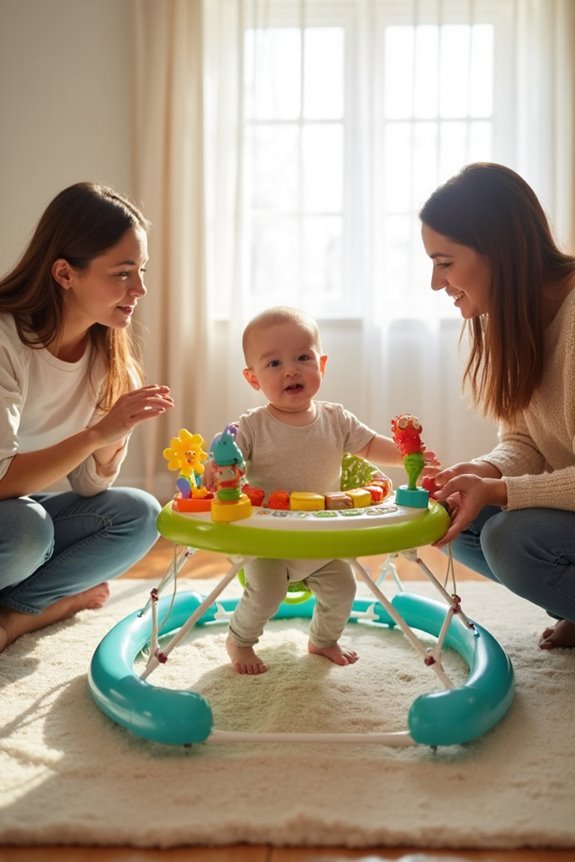To burp your baby safely and effectively, we can use different positions like holding them over your shoulder or sitting them on your lap. It’s important to support their head and back. Gently pat or rub their back while keeping them upright. Always use a burp cloth for spills. Monitor your baby’s comfort and adjust techniques as needed. After burping, we should hold them upright for a few minutes to ease any discomfort. You might find more helpful tips as we continue exploring this topic.
Key Takeaways
- Choose a comfortable position for burping, such as over the shoulder or sitting on your lap, to ensure baby feels secure.
- Support your baby’s head and back in an upright position while gently patting or rubbing their back to encourage gas release.
- Use a burp cloth to protect against spills and spit-up, ensuring a clean and comfortable burping experience.
- Experiment with different burping techniques and positions to find what works best for your baby’s comfort and effectiveness.
- After burping, hold baby upright for a few minutes and use gentle rocking motions to soothe them further.
Understanding the Importance of Burping
When we think about caring for our little ones, understanding the importance of burping becomes essential, especially since babies can swallow a lot of air during feeding. Burping offers several significant benefits that contribute to their digestive health.
- It helps release trapped air, preventing discomfort and belly aches.
- This practice supports healthy digestion, allowing our babies to feel more at ease.
- Burping can also aid in muscle development, as it encourages the release of gas.
Typically, we should burp our babies until they reach about 7-9 months, as their muscles mature. Ignoring this step can lead to sleep disturbances and fussiness, making it even more crucial for us to stay attentive to their needs during feeding times.
Choosing the Right Position for Burping

Choosing the right position for burping your baby can make a significant difference in their comfort and the effectiveness of the process. We can explore several burping techniques that suit different needs:
- Over the Shoulder: This is a classic method, allowing us to support the baby’s head while gently patting their back.
- Sitting on the Lap: Here, we can provide support under the chin and chest, leaning the baby forward slightly for optimal comfort.
- Lying Across the Lap: While this can be effective, we must be cautious, as it might cause discomfort for some babies.
- Face Down on the Lap: This position offers a different angle and can help some babies burp.
Techniques for Effective Burping

Effective burping techniques can significantly ease your baby’s discomfort after feedings, helping them release any trapped air that may cause fussiness. We can start by holding them upright against our chest, ensuring their chin rests on our shoulder. Alternatively, we can lay them on our lap, supporting their head, or use a rocking chair for a soothing experience.
Let’s gently pat or rub their back with our hand, experimenting with pressure until we find what works best. Remember, burping tools like towels or bibs can save us from messy cleanups. While there are many burping myths, these techniques are backed by experience and can truly support our little ones’ comfort during feeding times.
Safety Considerations During Burping

While burping your baby may seem straightforward, there are important safety considerations that we should keep in mind to ensure a comfortable and secure experience for our little one. Let’s focus on a few key aspects:
- Use a burp cloth to protect against spills and spit-up.
- Support your baby’s head and back in an upright position, helping them expel air comfortably.
- Pat gently, avoiding any sudden movements that could cause discomfort.
- Choose a safe location away from hazards, ensuring a soft surface is available in case of slips.
Handling Common Issues While Burping

When we’re burping our babies, it’s common to encounter a few challenges along the way. To tackle these burping challenges, we can adjust our techniques. Here are some tips:
- Frequent Burping: Burp our little ones more often, especially after feeding, to reduce swallowed air.
- Positioning: Experiment with different positions, like holding them upright on our shoulder or across our lap, until we find what works best.
- Monitor Feeding: Watch for signs of gulping during feeds and pause to burp if needed.
Post-Burping Care for Your Baby

After we’ve successfully burped our little one, it’s important to know how to care for them in a way that keeps them comfortable and content. We can start by holding our baby in a cradle position or keeping them upright for a few minutes to prevent any spit-up. Gentle rocking motions can also work wonders as soothing techniques.
Here are some tips for post-burping comfort:
- Swaddle your baby for a sense of security.
- Use a baby carrier to maintain an upright position.
- Watch for signs of discomfort, like fussing or arching.
If discomfort continues, we might consider adjusting feeding schedules or consulting a doctor. Let’s create a calming environment to help our little ones feel at ease.
Frequently Asked Questions
How Long Should I Burp My Baby After Feeding?
When we think about how long to burp our baby after feeding, we find a couple of minutes usually does the trick. Using various burping techniques during feeding intervals helps ensure our little one feels comfortable.
Can Burping Help Prevent Colic in Babies?
While we might think burping’s a magic trick for colic prevention, studies show it often isn’t. We should focus on gentle burping techniques, but remember, it’s not a guaranteed remedy for every baby’s fussiness.
Is It Safe to Burp a Sleeping Baby?
When it comes to our sleeping baby, we can explore gentle burping techniques. It’s often safe to let them rest, but if they’re uncomfortable, we might try a position that encourages natural air release without waking them.
What Should I Do if My Baby Won’T Burp?
We remember when our little one wouldn’t burp after feeding, leaving us worried. Trying different burping techniques, like gentle tummy massages, often helped. Let’s keep experimenting together until we find what works best for our babies.
At What Age Do Babies Outgrow the Need for Burping?
As our little ones reach age milestones around 4 to 6 months, we’ll notice reduced burping needs. Let’s pay attention to their cues and adapt our burping techniques for their comfort and growth together.





